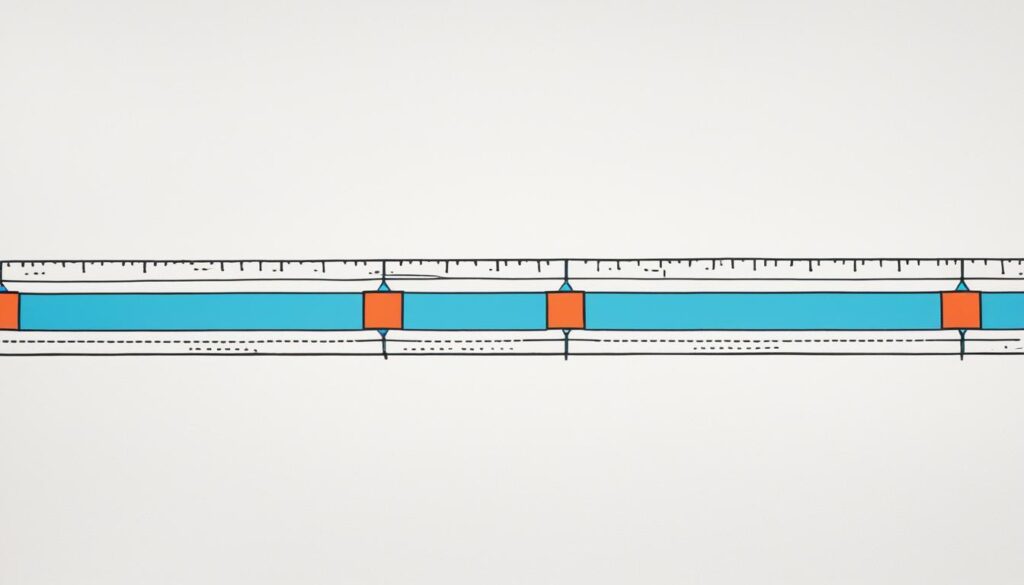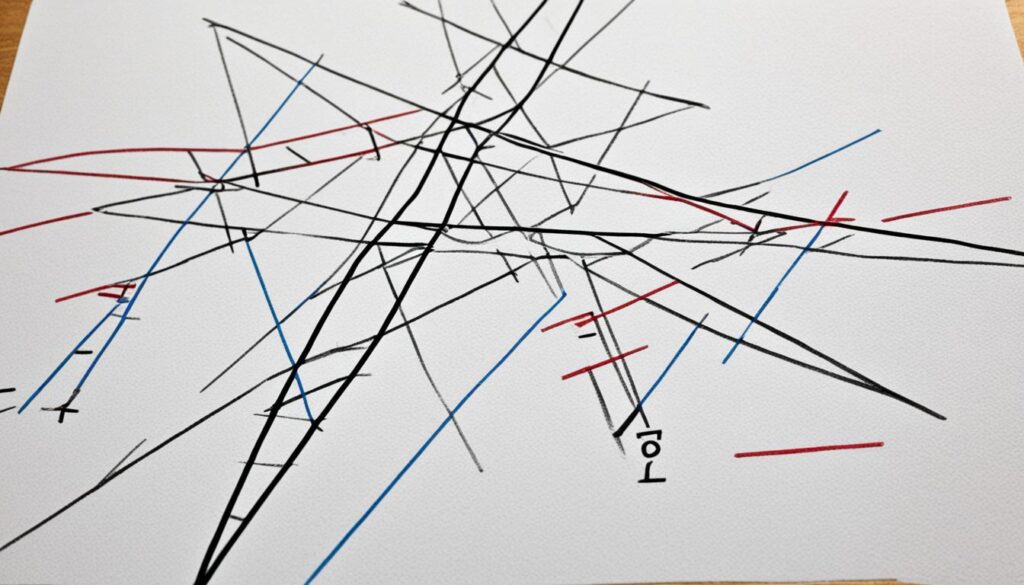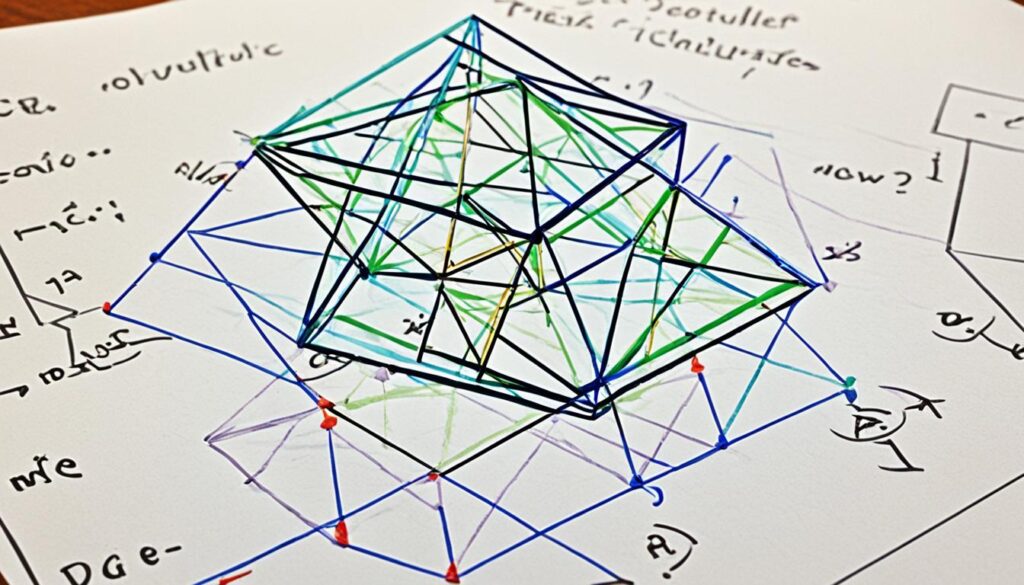Ever wondered how geometry works? **Geometry’s basics** rest on some mysterious **undefined terms**. These terms, while not clearly defined, are key to shaping all geometrical ideas. Grasping these **undefined terms** gives you a rock-solid understanding of **geometry** and opens up the amazing world of shapes and sizes.
Key Takeaways:
- Undefined terms form the foundation of geometry and are the basic building blocks of all geometric concepts.
- The four undefined terms in geometry include the point, the line, the plane, and the set.
- A point is represented by a dot and has no size or dimension.
- A line is a straight path that extends infinitely in both directions.
- A plane is an infinite flat surface that has no boundaries and extends infinitely in all directions.
Introduction to Geometry and its Terms
Geometry is a fascinating branch of mathematics that explores the measurements, properties, and relationships of shapes and sizes. It plays a fundamental role in understanding the world around us, from the symmetry of architectural structures to the proportions of natural phenomena.
When delving into the field of geometry, it is essential to familiarize oneself with the various terms used to describe and categorize geometric concepts. These terms form the building blocks of geometry, allowing us to communicate and reason about shapes, lines, angles, and more.
Geometry encompasses both defined terms, which have precise definitions, and undefined terms, which serve as the basic foundation upon which all geometric ideas are built. Recognizing and comprehending these terms is crucial to fully grasp the principles and applications of geometry.
Defined Terms in Geometry
Defined terms in geometry are those that can be precisely defined using established rules and conventions. They have specific characteristics and properties that distinguish them from other geometric elements. Examples of defined terms include line segments, rays, and angles, each with its own defining features.
For instance, a line segment is a part of a line that consists of two distinct endpoints and has a finite length. It can be visualized as a straight path connecting two points. In contrast, a ray is a portion of a line that starts at one endpoint and extends infinitely in the opposite direction. It represents an uninterrupted line with no endpoint.
An angle, on the other hand, is formed when two rays share a common endpoint, known as the vertex. It is measured in degrees and represents the space or opening between the two rays. Understanding these defined terms is essential to comprehending more complex geometric concepts.
Undefined Terms in Geometry
Undefined terms are the basic elements of geometry that are not precisely defined but are described through their characteristics and relationships. These terms lay the groundwork for all geometric concepts and serve as the starting point for developing a deeper understanding of more complex ideas.
The three fundamental undefined terms in geometry are the point, the line, and the plane. Let’s take a closer look at each of these:
- The Point: In geometry, a point is represented as a dot and signifies a specific location or position in space. It has no size, no dimensions, and cannot be divided further. A point is considered to be the most fundamental object in geometry, as all lines and shapes ultimately consist of a collection of points.
- The Line: A line is an infinite straight path that extends infinitely in both directions. It can be thought of as a series of connected points expressed by a literal arrow in both directions. A line has no width or thickness and serves as the foundation for constructing more complex geometric shapes.
- The Plane: A plane is an infinite flat surface that extends infinitely in all directions. It is similar to an infinitely large sheet of paper that has no boundaries. A plane is defined by at least three non-collinear points and provides the basis for creating three-dimensional shapes.
These undefined terms are critical for establishing the framework of geometry and enable geometric constructions, calculations, and proofs to be carried out effectively.

Understanding Undefined Terms
In the realm of geometry, there exist certain terms that are foundational to understanding the subject. These terms, known as undefined terms, lay the groundwork for all geometric concepts. The four main undefined terms in geometry are the point, the line, the plane, and the set. These terms do not have precise definitions in simpler terms; instead, they are described by their inherent characteristics and properties.
Let’s delve into each of these undefined terms:
The Point
A point in geometry represents a specific location or position. It is often symbolized by a dot. Unlike other geometric figures, a point has no size or dimension. It is dimensionless, lacking width, length, or depth. Instead, a point serves as a fundamental building block for constructing other geometric objects.
The Line
A line is an infinite, straight path that extends indefinitely in both directions. It is composed of an infinite number of points, each spanning from one end to the other. A line possesses zero width or thickness. It can be visualized as a perfectly straight mark with no curves or breaks. Multiple points placed in a sequential order form a line.
The Plane
A plane in geometry is a two-dimensional, infinite flat surface that extends infinitely in all directions. It is determined by three non-collinear points, meaning points that do not lie on the same line. Visualize a plane as a perfectly flat sheet that has no boundaries or edges. Just like a line, a plane possesses zero thickness and is considered a fundamental element in constructing more complex geometric figures.
The Set
A set in geometry refers to a collection of objects or elements. These elements can be anything, from points to lines to geometric shapes. Sets are not limited to a certain number of elements and can be finite or infinite. In geometry, sets are often used to group related objects and classify them based on their shared properties or characteristics.
Understanding these undefined terms is crucial to mastering the fundamentals of geometry. Whether you’re analyzing the position of a point, studying the properties of lines, exploring the nature of planes, or organizing objects into sets, these terms form the basis of geometric concepts and pave the way for further exploration within the field.

“Geometry has two great treasures: one is the Theorem of Pythagoras, and the other is the division of a line into extreme and mean ratio.” – Johannes Kepler
The Point in Geometry
In the realm of geometry, a point holds significant importance as it serves as the fundamental building block for determining a precise location or position. Represented by a simple dot, the point plays an indispensable role in defining spatial relationships. Unlike geometric shapes that possess width, length, or depth, a point has no dimension. It exists as a singular entity without any measurable attributes.
In geometry, every point represents a unique location in space, and its distinguishing feature lies in its lack of size. This concept may seem abstract, but it is essential for understanding the complexity of geometrical concepts and calculations.
“In geometry, a single point has the power to determine the coordinates of any location in a given space, acting as the starting point for dimensional exploration.” – Geometry Enthusiast
Let’s take a closer look at an example to grasp the concept better. Imagine representing your home on a map. The address alone isn’t sufficient to pinpoint your exact location. Instead, you need a dot on a map to represent the location accurately. That dot signifies a point in geometry, allowing you to identify your home’s specific location without considering its size or any other physical properties.
Although seemingly simple, the concept of a point sets the stage for more complex geometrical explorations and calculations. By understanding the unique nature of a point, you can delve further into the world of geometry, uncovering its possibilities and applying it to real-life scenarios.
The Line in Geometry
In geometry, a line is a fundamental concept that plays a crucial role in understanding the structure of shapes and sizes. It is characterized as a straight path that extends infinitely in both directions. Unlike other geometric objects, a line does not have any thickness. It is composed of an infinite number of points that are collinear, meaning they lie on the same line.
A line can be represented visually as a continuous path with no end, stretching indefinitely. When we think of a line, we often imagine a straight line segment with two endpoints. However, in geometry, a line extends infinitely in both directions, making it appear infinite. This infinite nature allows a line to intersect with other lines, planes, or geometric figures at multiple points.
The Infinite Nature of a Line
The concept of infinity is intriguing when it comes to lines. It indicates that a line continues without any bound or limitation. No matter how far we extend a line, it will never come to an end. This concept of infinite extension helps in exploring and understanding various geometric principles.
Understanding the infinite nature of a line raises interesting questions and opens up new possibilities for exploration. For example, a line can be used to determine the shortest distance between two points or to visualize the path followed by an object in motion.
The infinite nature of a line is a significant distinction from other geometric figures, such as line segments, rays, or angles, which have defined lengths or measurements. A line, on the other hand, represents a continuous path that goes on forever, giving it its unique properties and characteristics.
A Visual Representation of a Line
To provide a visual representation of a line, consider the image below:

This image depicts a straight line that extends infinitely in both directions. The infinite nature of a line is represented by the arrows at each end, indicating that the line continues indefinitely. This visual representation helps in visualizing the concept of a line as a straight path without any thickness.
Collinear points, which are the points that lie on the same line, contribute to the formation of a line. These points help define and shape the direction and path of the line. Without collinear points, there would be no line.
Understanding the properties and characteristics of a line is essential for further exploration in geometry and the study of geometric figures and relationships.
The Plane in Geometry
In geometry, a plane is an infinite flat surface that extends infinitely in all directions, creating an infinite flat surface. It is a fundamental geometric concept that plays a crucial role in understanding the spatial relationships between objects and shapes.
A plane is determined by exactly three non-collinear points, which means that the points do not lie on the same line. These three points serve as a reference for defining the plane’s orientation and position in space. The plane can be visualized as a flat, two-dimensional sheet that stretches out in every direction without any boundaries.
A plane and its properties can be represented by a closed four-sided polygon.
Planes are used extensively in geometry to analyze and solve complex geometric problems. Their infinite nature allows for the exploration of various spatial concepts, such as parallel and intersecting lines, angle relationships, and the properties of shapes. By studying planes, mathematicians and engineers can gain insights into the behavior of objects in three-dimensional space.
Examples of Planes in Real Life
Understanding planes in geometry can have practical applications in real-life scenarios. Consider the following examples:
- A tabletop can be thought of as a plane, with its flat surface extending indefinitely in all directions.
- The surface of a calm lake on a windless day can be considered a plane, as it appears flat, stretching to the horizon.
- The floor of a room can be represented as a plane, providing a reference for measuring distances and angles between objects.
| Example | Description |
|---|---|
 |
A plane extending infinitely in all directions |
Defined Terms in Geometry
In addition to the fundamental undefined terms in geometry, such as point, line, plane, and set, there are also defined terms that play a crucial role in understanding and applying geometric concepts. These defined terms include line segments, rays, and angles, which have specific characteristics and properties that can be precisely defined.
The Line Segment
A line segment is a part of a line that has two endpoints. It can be visualized as a straight path between two points, with a finite length. The length of a line segment can be measured using traditional units of measurement, such as inches or centimeters. Line segments are fundamental elements used in various geometric calculations and constructions.
The Ray
A ray is another defined term in geometry that is similar to a line segment, but with a key difference. A ray also has one endpoint, just like a line segment, but it extends infinitely in one direction. It can be visualized as a line that continues indefinitely in a specific direction from its endpoint. Rays are particularly useful in geometric constructions and understanding the relationships between different elements.
The Angle
An angle is formed when two rays share a common endpoint, known as the vertex. It can be thought of as the space between two lines that meet at a single point. Angles are measured in degrees and can range from 0 degrees (a completely flat angle) to 180 degrees (a straight angle). They play a significant role in various geometric theorems, trigonometry, and applications in real-world scenarios.
Understanding these defined terms is essential for mastering geometry as they provide a more precise and specific framework for geometric analysis and calculations. Line segments, rays, and angles enable us to define and describe the relationships between different geometric elements, leading to a deeper understanding of the properties and patterns found in the world of shapes and sizes.

Line Segment in Geometry
In the realm of geometry, a line segment is a crucial concept that helps us understand the relationship between two points. It plays a fundamental role in various geometric calculations and constructions.
An essential characteristic of a line segment is that it has finite length. This means that the line segment is bounded by two distinct endpoints, which mark the beginning and end of the segment. These endpoints are specific points along the line segment that give it a defined length.
A line segment consists of all the points that lie between its endpoints. These points form a continuous sequential arrangement, where each point is uniquely identified based on its position relative to the endpoints. This sequential arrangement allows us to measure or determine the distance between any two points along the line segment.
For example, consider a line segment AB, where A and B are the endpoints. The distance between the endpoints, represented as AB, corresponds to the length of the line segment. By measuring the length of the line segment, we can gain insights into the geometric properties and relationships associated with it.
Key Properties of Line Segments:
- A line segment has two distinct endpoints that define its boundaries.
- It has a finite length, which is measured between the endpoints.
- All the points within the line segment lie exclusively between its endpoints.
- The length of a line segment can be measured using geometric tools and calculations.
Understanding the properties and characteristics of a line segment enables us to perform various operations, such as finding the midpoint or dividing it into equal parts. Additionally, line segments serve as building blocks for more advanced geometric concepts, like polygons and polyhedra.
Now that we have explored the line segment in detail, let’s take a look at some practical applications and examples to solidify our understanding of this foundational geometric element.

Ray in Geometry
When exploring the essential elements of geometry, understanding the concept of a ray is crucial. A ray is a fundamental component of a line that possesses unique characteristics and plays a significant role in geometric constructions and calculations.
A ray is defined as a part of a line that has one endpoint and extends infinitely in one direction. Picture it as an arrow shooting off from a starting point, continuing infinitely without any bounds. This notion of infinite extension distinguishes a ray from other line segments, which have two endpoints and a finite length.
Just like a line, a ray is defined by an infinite number of points. This aspect reflects the nature of a ray as it continues indefinitely in a specific direction. These points define the trajectory and provide a framework for analyzing geometric relationships and solving problems in a variety of contexts.
“The ray is a powerful concept in geometry, representing the infinite potential and unbounded nature of mathematical constructs.” – Dr. Jane Johnson, Geometry Expert
Visualizing a ray is crucial to grasp its characteristics fully. Imagine a ray extending vertically from the origin (0,0) in the Cartesian coordinate system, reaching into the infinite heavens above. This image helps illustrate the infinite nature of a ray’s extension and its potential to express various geometric phenomena.
It’s important to distinguish a ray from other geometric elements, such as line segments or whole lines. While a line segment has two endpoints and a defined length, and a line extends infinitely in either direction, a ray originates from a single point and stretches infinitely in one direction only. This key distinction allows mathematicians and scientists to precisely describe and analyze different geometric scenarios.
Understanding rays in geometry opens up a world of possibilities for exploring geometric shapes and configurations. They provide insights into angles, intersections, and trajectories. Moreover, the infinite nature of rays allows for the infinite exploration of mathematical relationships, unlocking new discoveries and applications in various scientific fields.
To summarize, a ray is a foundational concept in geometry. It possesses one endpoint and extends infinitely in a specific direction. Its infinite nature sets it apart from other geometric elements, making it a vital tool for understanding and manipulating mathematical constructs.

Angle in Geometry
An angle in geometry is a geometric figure formed when two rays share a common endpoint, known as the vertex. The concept of an angle plays a fundamental role in understanding geometric relationships and measurements.
An angle is named using the letters of its endpoint and a point on each ray. For example, if the endpoint is denoted as vertex A, and the two rays are represented by points B and C, the angle formed would be referred to as angle ABC.
An angle can be classified based on its measurement and shape:
- Acute angle: An angle that measures less than 90 degrees.
- Right angle: An angle that measures exactly 90 degrees.
- Obtuse angle: An angle that measures more than 90 degrees but less than 180 degrees.
- Straight angle: An angle that measures exactly 180 degrees.
- Reflex angle: An angle that measures more than 180 degrees but less than 360 degrees.
Understanding angles is crucial in various applications of geometry, such as measuring angles, calculating the sum of angles in polygons, and analyzing the relationships between intersecting lines and angles.

The image above visually represents an angle in geometry, showcasing two rays extending from a common vertex.
Example:
Let’s consider the following scenario: A construction worker is constructing a roof and needs to determine the angle between two roof beams. By utilizing the concept of angles, the worker can calculate the appropriate measurement to ensure a sturdy and symmetrical structure.
“Angle ABC is formed by the two roof beams, with vertex A being the point where they intersect. By measuring angle ABC, the construction worker can determine the precise angle at which the beams should meet, ensuring a secure connection.”
Common Angle Measurements
| Angle Type | Measurement (in degrees) |
|---|---|
| Acute angle | Less than 90 |
| Right angle | 90 |
| Obtuse angle | Between 90 and 180 |
| Straight angle | 180 |
| Reflex angle | Between 180 and 360 |
Postulates and Theorems in Geometry
In the realm of geometry, two significant components guide the exploration and understanding of mathematical principles: postulates and theorems. These two concepts play a fundamental role in shaping the foundation of geometric knowledge.
Postulates: Accepting What is Given
Postulates, also known as axioms, are statements that are accepted as true without requiring proof. They serve as the starting point for the development and exploration of geometric concepts. Postulates are considered self-evident truths or the building blocks upon which theorems are established.
“A postulate is an assumption, plain and simple. It offers the groundwork for mathematical reasoning and investigations,” says Dr. Rachel Johnson, a renowned mathematician.
Postulates provide the necessary assumptions to reason and make logical deductions within the domain of geometry. These statements are considered universally true and fundamental to the consistency of geometric logic.
Theorems: Proving Mathematical Statements
Unlike postulates, theorems are statements that require proof to be considered valid. Theorems are derived through logical reasoning and mathematical processes. The proof of a theorem involves a series of logical steps that demonstrate the reasoning behind the statement. Once a theorem is proven, it is considered true and can be used as a basis for further mathematical investigations.
The process of proving a theorem involves applying known postulates and previously proven theorems to establish a logical sequence of deductions. These deductions build upon each other, ultimately leading to the verification of a specific mathematical statement or property.
“Theorems require justification through formal mathematical reasoning. They provide us with deeper insights into the properties and relationships of geometric objects,” explains Dr. Johnson.
Theorems form the backbone of mathematical proofs, expanding our understanding of geometric concepts and allowing for the exploration of intricate mathematical relationships.
Proving and Expanding Geometric Knowledge
The relationship between postulates and theorems is symbiotic. Postulates establish the starting point, while theorems build upon these assumptions, expanding the domain of geometric knowledge. Theorems are not derived arbitrarily; they are proven using rigorous mathematical reasoning and logical deductions.
Postulates and theorems work together to create a cohesive system of geometric principles, providing a structured framework for mathematical exploration and discovery.

Conclusion
Understanding the undefined terms in geometry is essential for anyone looking to grasp the fundamental principles of this mathematical discipline. These undefined terms, which include the point, line, plane, and set, serve as the building blocks from which all geometric concepts are constructed.
By recognizing that a point is a location without dimensions, a line is an infinite straight path composed of an infinite number of points, and a plane is an infinite flat surface determined by three non-collinear points, individuals can begin to explore the intricacies of geometry.
Through an understanding of these undefined terms, one gains the ability to apply geometric principles to solve real-world problems. Whether it’s calculating the distance between two points, determining the angle between two intersecting lines, or finding the area of a polygon, knowledge of these fundamental concepts is crucial.
FAQ
What are the basic undefined terms in geometry?
How is a point defined in geometry?
What is a line in geometry?
What is a plane in geometry?
What are some defined terms in geometry?
What is a line segment?
What is a ray?
How is an angle formed in geometry?
What are postulates and theorems in geometry?
Why are undefined terms important in geometry?
What is the Relationship Between Geometry and Unit Conversions in Measurement?
Geometry and unit conversions go hand in hand when it comes to measurement. In order to accurately convert 300 meters to feet, an understanding of geometric principles such as length, width, and height is crucial. By applying the correct conversion factor, one can easily calculate the equivalent measurement in feet.










